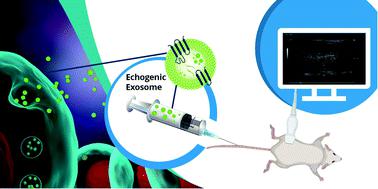当前位置:
X-MOL 学术
›
Nanoscale Adv.
›
论文详情
Our official English website, www.x-mol.net, welcomes your feedback! (Note: you will need to create a separate account there.)
Echogenic exosomes as ultrasound contrast agents
Nanoscale Advances ( IF 4.7 ) Pub Date : 2020-06-18 , DOI: 10.1039/d0na00339e Jenna Osborn 1 , Jessica E Pullan 2 , James Froberg 3 , Jacob Shreffler 2 , Kara N Gange 4 , Todd Molden 5 , Yongki Choi 3 , Amanda Brooks 2 , Sanku Mallik 2 , Kausik Sarkar 1
Nanoscale Advances ( IF 4.7 ) Pub Date : 2020-06-18 , DOI: 10.1039/d0na00339e Jenna Osborn 1 , Jessica E Pullan 2 , James Froberg 3 , Jacob Shreffler 2 , Kara N Gange 4 , Todd Molden 5 , Yongki Choi 3 , Amanda Brooks 2 , Sanku Mallik 2 , Kausik Sarkar 1
Affiliation

|
Exosomes are naturally secreted extracellular bilayer vesicles (diameter 40–130 nm), which have recently been found to play a critical role in cell-to-cell communication and biomolecule delivery. Their unique characteristics—stability, permeability, biocompatibility and low immunogenicity—have made them a prime candidate for use in delivering cancer therapeutics and other natural products. Here we present the first ever report of echogenic exosomes, which combine the benefits of the acoustic responsiveness of traditional microbubbles with the non-immunogenic and small-size morphology of exosomes. Microbubbles, although effective as ultrasound contrast agents, are restricted to intravascular usage due to their large size. In the current study, we have rendered bovine milk-derived exosomes echogenic by freeze drying them in the presence of mannitol. Ultrasound imaging and direct measurement of linear and nonlinear scattered responses were used to investigate the echogenicity and stability of the prepared exosomes. A commercial scanner registered enhancement (28.9% at 40 MHz) in the brightness of ultrasound images in presence of echogenic exosomes at 5 mg mL−1. The exosomes also showed significant linear and nonlinear scattered responses—11 dB enhancement in fundamental, 8.5 dB in subharmonic and 3.5 dB in second harmonic all at 40 μg mL−1 concentration. Echogenic exosomes injected into the tail vein of mice and the synovial fluid of rats resulted in significantly higher brightness—as much as 300%—of the ultrasound images, showing their promise in a variety of in vivo applications. The echogenic exosomes, with their large-scale extractability from bovine milk, lack of toxicity and minimal immunogenic response, successfully served as ultrasound contrast agents in this study and offer an exciting possibility to act as an effective ultrasound responsive drug delivery system.
中文翻译:

回声外泌体作为超声造影剂
外泌体是天然分泌的细胞外双层囊泡(直径 40-130 nm),最近被发现在细胞间通讯和生物分子传递中发挥关键作用。它们的独特特性——稳定性、渗透性、生物相容性和低免疫原性——使它们成为用于提供癌症治疗剂和其他天然产品的主要候选者。在这里,我们首次报道了回声外泌体,它将传统微泡的声学响应性与外泌体的非免疫原性和小尺寸形态相结合。微泡虽然作为超声造影剂有效,但由于它们的大尺寸而仅限于血管内使用。在目前的研究中,我们通过在甘露醇存在下冷冻干燥牛乳来源的外泌体,使它们具有回声。超声成像和线性和非线性散射响应的直接测量用于研究制备的外泌体的回声性和稳定性。在存在 5 mg mL 回声外泌体的情况下,商业扫描仪记录了超声图像亮度的增强(40 MHz 时为 28.9%)-1。外泌体还显示出显着的线性和非线性散射响应——在 40 μg mL -1浓度下,基波增强 11 dB,次谐波增强 8.5 dB,二次谐波增强 3.5 dB注射到小鼠尾静脉和大鼠滑液中的回声外泌体可显着提高超声图像的亮度(高达 300%),显示出它们在各种体内应用中的前景。回声外泌体具有从牛奶中大规模提取的能力、无毒性和最小的免疫原性反应,在本研究中成功地用作超声造影剂,并为充当有效的超声响应药物递送系统提供了令人兴奋的可能性。
更新日期:2020-08-11
中文翻译:

回声外泌体作为超声造影剂
外泌体是天然分泌的细胞外双层囊泡(直径 40-130 nm),最近被发现在细胞间通讯和生物分子传递中发挥关键作用。它们的独特特性——稳定性、渗透性、生物相容性和低免疫原性——使它们成为用于提供癌症治疗剂和其他天然产品的主要候选者。在这里,我们首次报道了回声外泌体,它将传统微泡的声学响应性与外泌体的非免疫原性和小尺寸形态相结合。微泡虽然作为超声造影剂有效,但由于它们的大尺寸而仅限于血管内使用。在目前的研究中,我们通过在甘露醇存在下冷冻干燥牛乳来源的外泌体,使它们具有回声。超声成像和线性和非线性散射响应的直接测量用于研究制备的外泌体的回声性和稳定性。在存在 5 mg mL 回声外泌体的情况下,商业扫描仪记录了超声图像亮度的增强(40 MHz 时为 28.9%)-1。外泌体还显示出显着的线性和非线性散射响应——在 40 μg mL -1浓度下,基波增强 11 dB,次谐波增强 8.5 dB,二次谐波增强 3.5 dB注射到小鼠尾静脉和大鼠滑液中的回声外泌体可显着提高超声图像的亮度(高达 300%),显示出它们在各种体内应用中的前景。回声外泌体具有从牛奶中大规模提取的能力、无毒性和最小的免疫原性反应,在本研究中成功地用作超声造影剂,并为充当有效的超声响应药物递送系统提供了令人兴奋的可能性。



























 京公网安备 11010802027423号
京公网安备 11010802027423号